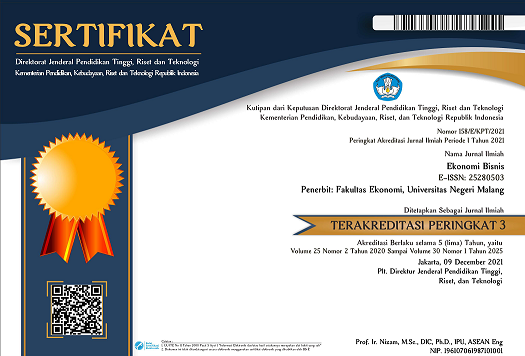The Aviation Industry Development and The Economic Growth in Indonesia
Abstract
Full Text:
PDFReferences
Amin, A. P. (2013). Analisis Pengaruh Tarif Penerbangan dan Pendapatan per kapita dalam meningkatkan jumlah penumpang. Jurnal Bisnis Strategi, Vol. 22(1), 49-66.
Badan Pusat Statistik. Statistik Transporasi Darat
Badan Pusat Statistik. Statistik Transporasi Udara
Erjongmanee, S., & Kongsamutr, N. 2018. Air Passanger Estimation Using Gravity Model and Learning Approach: Case Study of Thailand. 5th International Conference on Advanced Informatics: Concept Theory and Applications (ICAICTA)
Goetz, A. R., (1992). Air passenger transportation and growth in the US urban system, 1950-1987.
Higgoda, R., Madurrapperuma, W. (2019). Dynamic Nexus between Air-Transportation and Economic Growth: A Systematic Literature Review. Journal of Transportation Technologies, Vol. (9), 156-170
Hu, Y., Xiao, J., Deng, Y., Xiao, Y., & Wang, S. 2015. Domestic Air Passanger Traffic and Economic Growth in China: Evidence from Heterogenous Panel Models. Journal of Air Transport Management, 42, 95-100.
Kompas, April 23, 2010. Penumpang Pesawat turun.
Lohne, M. & Skrbo, N. 2020. Machine Learning in The Aviation Industry and Potential of Using Air Traffic as Real-time indicator GDP. Master Thesis. Norwegian School of Economics. https://openaccess.nhh.no/nhh-xmlui/bitstream/handle/11250/2735120/masterthesis.pdf?sequence=1
Novaldhy, W. (2013). Pengaruh Perdagangan Internasional terhadap Pertumbuhan Ekonomi di Indonesia (2003-2010). Sarjana’s Tesis. Universitas Negeri Malang. http://repository.um.ac.id/id/eprint/41426
Pindyck, R.S., Rubinfeld, D.L., & Rabasco, E. (2013). Microeconomics. Pearson.
Rahmadhani, T, Hamidi, W., Widayatsari, A. (2017). Permintaan jasa angkutan di Bandara Sultan Syarif Kasim II. Jurnal Online Mahasiswa Fakultas Ekonomi Universitas Riau.
Warpani, S. P. (Suwardjoko Probonagoro). (2002). Pengelolaan lalu lintas dan angkutan jalan. Bandung: Penerbit ITB.
Woodruff, R. B., 1997. Customer value: the next source for competitive advantages. Journal of the Academy of Marketing Service 25 (2), 139–153.
Zeithaml, V.A., 1988. Consumer perceptions of price, quality, and value: a means-end model and synthesis of evidence. Journal of Marketing 52 (July), 2–22.
Yao, S., & Yang, X. 2008. Airport Development and Regional Economic Growth in China. Research Paper 2008/07. papers.ssrn.com. https://core.ac.uk/download/pdf/6402164.pdf
DOI: http://dx.doi.org/10.17977/um042v26i2p86-96
Refbacks
- There are currently no refbacks.

This work is licensed under a Creative Commons Attribution-ShareAlike 4.0 International License.
Ekonomi Bisnis is licensed under a Creative Commons Attribution-ShareAlike 4.0 International License



